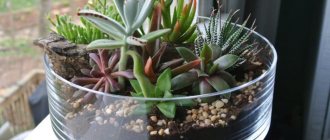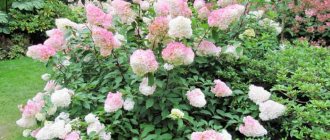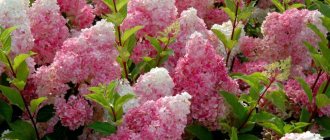Until recently, I had only seen and heard about this plant, but for the holidays I was given hydrangea or, as this plant is also called, hydrangea, in the form of a potted plant. Of course, the flowers are simply amazing: large and bright. The flower brings an indescribable atmosphere to the room.
In general, the plant is unpretentious, but there are still a number of requirements that must be met. Today we’ll talk about planting, propagating and caring for a flower like hydrangea, but let’s start with a description and basic characteristics.
Description
Hydrangea, or in the modern classification Hydrangea, is one of the most popular indoor and garden plants.
It received its name in honor of Princess Hortense. Later, scientists, while systematizing genera and species, gave it the name Hydrangea, taking as a basis the Greek words hydor and angeion - water and vessel. However, the former name remains more popular among amateur gardeners. Hydrangea belongs to the Hydrangeaceae or Hydrangiaceae family and is represented by 35 species. Their range, depending on the species, is quite wide: the countries of Southeast Asia and North America. Hydrangea is cultivated almost everywhere where conditions are suitable for its normal growth.
The genus is a shrubby or liana-like plant. The latter can reach a length of 30 m. Deciduous hydrangeas are more common, that is, they shed their foliage during the dormant period. As popular as the plant is, it is also recognizable thanks to its beautiful flowers of various shades, collected in large spherical or paniculate inflorescences.
Under natural conditions, the vast majority of Hydrangeas are white, but among cultivated species the shades are very diverse: pink, blue, purple, red. The color also depends on the acidity level of the soil. There are varieties with different shades in one inflorescence and corrugated edges of the petals.
The leaves of the plant are large, bright green, up to 10 cm in length. They have an oval shape with a pointed tip. The edge is decorated with small teeth. The greenery of the leaves effectively sets off the attractive inflorescences.
Such a variety of shapes and colors, a long flowering period, plus simple care allow Hydrangea to be widely used in interior design. In the warm season, it is recommended to keep it outdoors: on balconies, verandas, and in shaded areas of the garden.
Reproduction
This procedure can be carried out in several ways: by seeds, cuttings and by dividing the bush. Let's consider the simplest and most convenient way to propagate the Hydrangea macrophylla bush.
Cuttings
- It is better to hold the event from the end of January to the beginning of February.
- If the cuttings take root at this time, then next fall you will already have a bush with 3 - 5 branches. If cuttings are carried out later (in March and before the first half of April), then the bush will turn out to have only 1 stem.
- To get cuttings 7 - 8 cm long, take root shoots. Each shoot must have at least 3 internodes.
- The lower part of the cuttings is cleared of leaves and placed in a solution with a growth stimulator, and the upper leaves are shortened by 1/3 or half.
- Next, place the sprout in a soil mixture consisting of peat and river sand. Place the container in a well-lit place at a temperature of at least +18 - 20 degrees Celsius. Humidity should be at least 75 - 80%.
- To preserve sprouts in greenhouse conditions, you need to place halves of plastic bottles or glass jars on top. Periodically, the covers need to be removed, the soil and plants should be ventilated, and the soil should be moistened.
- After about 4 weeks, transplant the rooted shoots into separate pots with a circumference of 8 - 10 cm.
Rest period
After the hydrangea has bloomed, it must be prepared for wintering. To do this, at the beginning of December you need:
- cut off leaves and weak shoots;
- remove tops;
- cut strong stems by half;
- place in a dark place with a temperature no higher than 10 degrees;
- Water no more than once a month.
The flower's dormant period lasts until the end of winter. At this time, the owners will be pleased with the photo of the hydrangea taken at the moment of its luxurious flowering.
Fertilizer
Feeding plays an important role in care. Hydrangea Mix needs a variety of supplements. There are the following methods and rules of fertilization:
- If yellow leaves appear on the plant, it is necessary to acidify the soil. Mix 2 liters of water and 10 drops of lemon juice. Water once every 2 weeks.
- To accelerate flowering, spray hydrangea Mix with the following solution: 2 liters of water and 0.2 grams of gibberellin.
- In February it is necessary to carry out the first feeding of the plant. A professional complex fertilizer with a low alkali content is suitable for it.
- During growth and flowering, fertilizing should be done 2 times a month.
- From time to time you should add a little potassium permanganate to the water for irrigation. It will destroy bacteria and fungi.
Answers to frequently asked questions
Is the solution suitable for regular watering, for example, for treating flowers and vice versa?
No, under no circumstances should you use the prepared solutions for other purposes. Maintaining the recommended proportions for each situation is extremely important.
To treat which flower diseases is hydrogen peroxide effective?
Such solutions are suitable for treating mold and fungal diseases. It is worth noting that peroxide can only help in the initial stages of the disease or as a preventive measure.
Is it possible to use peroxide as a growth stimulant instead of Epin?
The experience of many gardeners suggests that peroxide has almost the same effectiveness as Epin. At the same time, Epin is much more expensive. However, never try to use these two drugs at the same time.
The most popular varieties of indoor hydrangea
This unique plant is very loved by many housewives. It looks beautiful on the windowsills of apartments, adding summer uniqueness.
The best varieties:
- Soeur Therese, M-me E. Mouillere – differ in white and cream shades;
- Europe, Goliath, Hamburg – pink species;
- Red Sensation and Prima – rich carmine shades;
- Ramars Mars – large-leaved hydrangea with cornflower blue flowers;
- Airlie Blue – sapphire shades.
The color of flowers depends on the content of hydrogen ions in the soil . For example, blue is provided by acidic soils, shades of pink appear in an alkaline environment, and beige depends on a neutral pH.
How to dilute hydrogen peroxide for flowers
You will not just need to make a mixture of hydrogen peroxide for watering indoor flowers. The proportions must be precisely maintained so as not to harm the flower garden. You also need to know how often to apply peroxide when growing indoor flowers.
REFERENCE! In all cases, the working solution for both processing and feeding indoor flowers will be prepared from a 3% variety of the drug. The advantage is that it can be easily found in any pharmacy. Pure H2O2 preparation, undiluted with water, is never used!
Hydrogen peroxide solution for watering flowers proportions
Now we’ll tell you exactly how to use hydrogen peroxide for watering indoor flowers. The proportions must be maintained as follows: on average 2 drops of peroxide per 1 liter of water.
How to dilute peroxide for spraying indoor plants, proportions
To prepare a spray product, pour 2-3 tablespoons (30-50 ml) of H2O2 into 1 liter of filtered and definitely settled water at a temperature of 20-24 degrees (that is, in a ratio of approximately 1:25).
Treatment with this mixture is carried out as necessary for each type of flower crop individually (suitable for daily treatment).
Flower growers claim that a positive effect can be observed after 10-12 days (growth of green mass, brighter color of leaves and flowers).
There is also a known recipe for a treatment product, the action of which is aimed at preventing the appearance of pests on indoor flowers.
Mix 20 ml of aseptolin or alcohol, 50 ml of H2O2 in 900 ml of water, and also add a very small drop of dishwashing detergent. It is recommended to carry out the treatment every day so that the prepared mixture gets onto all areas of the leaf blades and stems.
If you plan to use this treatment to cope with the development of diseases or parasitic insects, you will need to pour 2 tablespoons of peroxide (30 ml) and 2 drops of iodine into 1 liter of water. Spray every day for 7 days.
How to Use Hydrogen Peroxide to Soak Flower Seeds
Soaking seeds in an aqueous solution with the addition of H2O2 helps to increase the degree of germination and also accelerates the germination process itself.
In addition, during the soaking process, bacteria, viruses, and fungal spores that cause diseases will be destroyed.
It will be enough to soak the seed material for 2-3 hours in an aqueous mixture with a ratio of peroxide and water of 3:500 (that is, 1.5 ml of H2O2 in 250 ml of water).
How to use hydrogen peroxide as a room fertilizer
The mixture for feeding is prepared by pouring 1 tablespoon (15-18 ml) of peroxide into 1 liter of settled water (that is, in a ratio of approximately 1:63). Fertilize with the prepared product every 5-7 days.
NOTE! The temperature of the finished mixture should not be below room temperature so that the flowers do not experience stress.
Also sometimes mixtures are prepared for feeding, to which not only peroxide is added, but also granulated sugar as a source of glucose.
The algorithm for preparing the nutritional mixture is as follows:
- you will need 100 ml of peroxide, to which you need to add half a glass (100 g) of sugar;
- mix thoroughly until a homogeneous mass is formed;
- pour 2 liters of warm water into the resulting mixture and mix thoroughly;
- ready-made fertilizer is introduced instead of regular irrigation.
Diseases and pests of hydrangea
Many novice flower growers are interested: if the leaves dry out , what to do? As a rule, such problems are observed due to improper care. Solving them is quite simple.
Diseases and their treatment:
- Spider mites and aphids are a consequence of low humidity. Leaves and shoots are treated with a soap solution or actellik.
- Gray rot is the result of overwatering. The best remedy is Bordeaux mixture .
- Yellowed leaves - weak watering, lack of nitrogen or alkalization of the soil. Watering with iron sulfate (10 g/l) or iron sulfate (2 g/l) will help.
- Dry tips of leaves - a lack of fertilizer or errors in watering (it is the last point that most often is the answer to the question: why do the leaves dry). The problem can be resolved experimentally.
- Violation of the rest regime leads to a lack of flowering.
- If the leaves are affected by light spots, provide the plant with a shaded area .
Important! Leaf diseases and treatment of different varieties of hydrangea are similar.
Beautiful hydrangea will add a touch of sophistication to any interior. Perfect for apartments, offices, terraces and winter gardens.
Why do flowers need hydrogen peroxide?
Hydrogen peroxide (H2O2) is considered an ideal option for disinfecting indoor flowers. It helps prevent the development of fungal, viral and bacterial infections in both healthy and damaged flowers.
H2O2 will also help stop the processes of rotting of the root system, disinfect and saturate the soil with oxygen, and also speed up flowering.
INTERESTING! If an indoor flower begins to fade, then hydrogen peroxide can revive it.
Home care
For good development and colorful flowering, this plant needs to create comfortable growing conditions. In addition, it is very important to take proper care after purchase and timely replant and propagate the plant.
This video will tell you about the rules for growing hydrangeas in pots.
Flower location: light and temperature conditions
Hydrangea is a light- and heat-loving plant , but does not tolerate extremes. It is especially difficult to keep things cool in the summer. After all, even at the height of the heat, the air temperature should be no more than + 20–22 degrees.
Important! The extremely low indicator for winter is + 10 degrees. In this case, a glazed balcony will help out. Avoid sudden changes in temperature and drafts.
Another important point is the amount of light. Many people, not knowing how to care for hydrangea, place it on southern windows. But direct sunlight is a taboo for hydrangea. In order for it to fully develop and have consistently large flowers, take care of bright, diffused light .
Do not move the pot close to the window glass . A suitable distance is 1–2 meters. The south side of the house is best.
In winter, you need to give the plant a rest - move it to a shaded and cool place at least until February. In this case, next year the hydrangea will bloom again.
Watering the flower and the required humidity
Before watering, you need to let the tap water sit for several hours. In general , hydrangea loves water very much . The intensity and frequency of irrigation depend on the time of year. In the summer heat, plenty of moisture is required. The leaves are regularly sprayed with a fine spray bottle.
In the spring and autumn months - moderate, and in winter, watering is stopped altogether . It is replaced by periodically moistening the top layer of soil. It is unacceptable to use hard water. Settling or freezing will help soften it. Remember that cold water when watering has a detrimental effect on the condition of the roots.
Transfer rules
This procedure must be carried out annually; it determines whether it will bloom next year. It is best to replant hydrangeas after flowering in the fall .
Important! The size of the container increases by only a couple of centimeters. Transplantation is best done using a gentle transshipment method, leaving the original earthen lump on the roots.
The bottom is covered with a layer of drainage , then the pot is completely filled with new soil. Peat is good for mulching. It will help retain moisture longer.
Hydrangea is very demanding on the composition of the soil, so before replanting the plant, you need to prepare the substrate . On the one hand, you can try to pick up a ready-made mixture in the store, on the other hand, it’s better to prepare the soil yourself.
The following soil mixture composition is considered exemplary: turf (one part) + leaf soil (3), sand + peat (2 components of both).
Fertilizers and fertilizing
First of all, you need to know that when hydrangea blooms, fertilizing is not recommended . For indoor specimens, the same fertilizers as for other flowering plants are suitable. The frequency of feeding is approximately once every two weeks.
This mode is ideal for the active development phase. In winter, indoor hydrangea does not need fertilizer .
Decorative pruning
This is a privilege not only for garden species. The potted bush should also look neat. It is recommended to definitely get rid of sluggish and non-viable shoots before wintering, when the flowering phase is already behind.
The next procedure is carried out with the arrival of spring . Then the overgrown shoots are pruned.
Common mistakes
- If you use H2O2 to water or spray indoor flowers and non-flowering plant crops, make sure that the soil surface is not littered with fallen or dry leaves, inflorescences and stems. Otherwise, decay processes may be activated;
- The prepared hydrogen peroxide solution cannot be stored; it is used only freshly prepared, since hydrogen peroxide molecules decompose over time;
- Take seriously the proportions in accordance with which you need to prepare the working product at home, otherwise you may end up with burned, dying plants. The burned root system will appear as spots on the leaves;
- If after watering and spraying you begin to observe a white coating on the leaves, roots and stems, then you should stop using peroxide immediately (at least for a short period of time).
For which plants should hydrogen peroxide not be used?
There are two types of restrictions for fertilizing or treating with hydrogen peroxide, which are associated either with certain types of flowers or with the condition of the plant:
- flowers with double or translucent inflorescences and leaves (for example, violets, pelargonium) cannot be sprayed with products containing H2O2 to avoid initiating rotting processes. Watering should be done with extreme caution. As a fertilizer for succulents, it is better to give preference to special complex preparations for them;
- While indoor flowers are at rest, when all vital processes are suspended, peroxide solutions cannot be used either.











